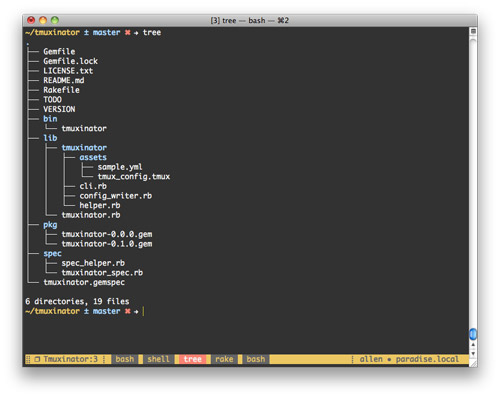

- #Tmuxinator layout options install
- #Tmuxinator layout options license
- #Tmuxinator layout options windows
For example, to change between panes, you can use Ctrl + b, arrow-key. Hopefully the comments should be self explanatory, there are a lot more things I could do here but starting off simple is the way to go for me. As for navigation, the default for Tmux is to use Ctrl + b, then the action button. # reload config file (change file location to your the nf you want to use) # switch panes using Alt-arrow without prefix Set-window-option -g monitor-activity off Here are some of my specific configuration in ~/.nf # Use mouse like a peasant I’m not really going to go into the depths of using of using TMUX - this post by Hermann Vocke does a much better job than I can explaining the cool things you can do. The default permits direct access to the terminal attached to the window the other is copy mode. The config uses YAML which is nice and human readable and you can add your config files to a gist or dotfile repo if you want. A tmux window may be in one of several modes. The reason I use Tmuxinator is it’s a great way to set environment setups that persist through reboot.
#Tmuxinator layout options install
Installation - TMUX # sudo apt upgradeĭone Installation - Tmuxinator # gem install tmuxinator
#Tmuxinator layout options windows
It’s not until the past few weeks where I’ve spent most of my time in the terminal for various projects that I’ve really felt the need to dig in and learn the basics. 1 I' trying to build a tmuxinator with multiple windows and in one of them id like to build 2 panes: name: bigbang-server root: /projects/bigbang windows: - CORE:.
#Tmuxinator layout options license
See LICENSE for further details.I’ve known about TMUX for a few years now but never got around to checking it out. CopyrightĬopyright (c) 2010-2013 Allen Bargi. To contribute, please read the contributing guide. tmuxinator version FAQ Window names are not displaying properly?Īdd export DISABLE_AUTO_TITLE=true to your. Shows the shell commands that get executed for a project tmuxinator debug Aliased to i tmuxinator implodeĮxamines your environment and identifies problems with your configuration tmuxinator doctor Remove all tmuxinator configs, aliases and scripts. List all the projects you have configured. mux Other CommandsĬopy an existing project. tmuxinator start ShorthandĪn shorthand alias for tmuxinator can also be used. This will fire up tmux with all the tabs and panes you configured. I thought the concept of layouts was really cool, and it felt nice to use, but there are several drawbacks that are addressed by. These command(s) will run before any subsequent commands in all panes and windows. To use tmuxinator with rbenv, RVM, NVM etc, use the pre_window option. After installing Tmuxinator, you can define a project using: This will create a YAML configuration file for the project with comments describing the available options. It allows me to type that quick command and have everything ready to go. Interpreter Managers & Environment Variables Tmuxinator bills itself by saying 'Create and manage tmux sessions easily'. The layout setting gets handed down to tmux directly, so you can choose from In the following example, the editor window has 2 panes, one running vim, the other guard. Panes are optional and are children of window entries, but unlike windows, they do not need a name. Each window is denoted by a YAML array entry, followed by a name

The windows option allows the specfication of any number of tmux windows. Useful for setting up interpreter versions. # Runs in each window and pane before window/pane specific commands. If this is a new project you will see this default config: # ~/.tmuxinator/sample.yml Your default editor ( $EDITOR) is used to open the file. Create a projectĬreate or edit your projects with: tmuxinator new įor editing you can also use tmuxinator open. If not please consult the man pages for tmux. The following are example where the completion file has been downloaded intoĪdd the following to your ~/.bashrc: source ~/.bin/tmuxinator.bashĪdd the following to your ~/.zshrc: source ~/.bin/tmuxinator.zshĪ working knowledge of tmux is assumed. If you use a base-index other than the default, please be sure to also set the pane-base-index set-window-option -g pane-base-index 1ĭownload the appropriate completion file from the repo and source the file. You're mileage may vary forĮarlier versions. The recommended version of tmux to use is 1.8. Mine looks like this: export EDITOR = ' vim ' tmux If you're notįor me that produces "vim" If you want to change your default editor simply Tmuxinator uses your shell's default editor for opening files. Installation gem install tmuxinator Editor and Shell


 0 kommentar(er)
0 kommentar(er)
